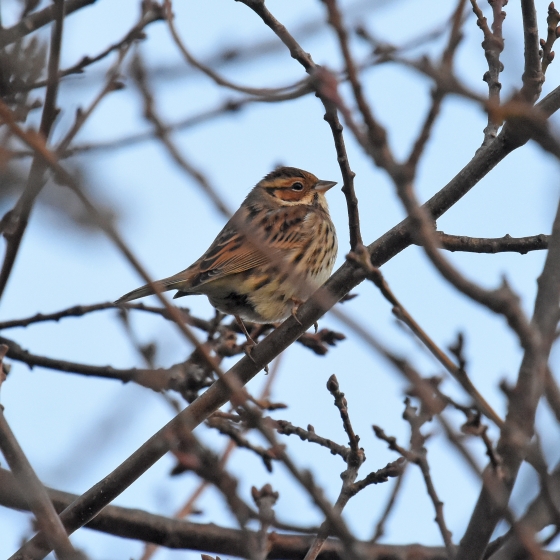Little Bunting
Emberiza pusilla (Pallas, 1776)
LJ
 LITBU
LITBU  18740
18740

Family: Passeriformes > Emberizidae

Resembling a Linnet-sized female Reed Bunting, this is a scarce visitor from Russia. Most records come from the autumn, although increasing numbers are being found in winter finch and bunting flocks.
Identification
Little Bunting identification is sometimes difficult. The following article may help when identifying Little Bunting.
Identifying winter buntings

If you find brown, streaky buntings hard to identify, this workshop is for you. Using video footage, still photographs and sound recordings we highlight the differences between four species of bunting that can be found in coastal areas in winter: Reed, Little, Snow and Lapland Buntings.
SONGS AND CALLS
Listen to example recordings of the main vocalisations of Little Bunting, provided by xeno-canto contributors.
Call
Develop your bird ID skills with our training courses
Our interactive online courses are a great way to develop your bird identification skills, whether you're new to the hobby or a competent birder looking to hone your abilities.
Browse training coursesStatus and Trends
Population size and trends and patterns of distribution based on BTO surveys and atlases with data collected by BTO volunteers.
CONSERVATION STATUS
This species can be found on the following statutory and conservation listings and schedules.
DISTRIBUTION
This species is a rare vagrant and was recorded during Bird Atlas 2007–11 as shown on the map.
Occupied 10-km squares in UK
| No. occupied in winter | 12 |
| % occupied in winter | 0.4 |
European Distribution Map
DISTRIBUTION CHANGE
This vagrant is too rarely reported to map distribution change.
| % change in range in winter (1981–84 to 2007–11) | +266.7% |
SEASONALITY
Little Bunting is a scarce vagrant most often encountered during autumn migration, although some birds remain to winter and can be seen on spring migration.

Movement
Information about movement and migration based on online bird portals (e.g. BirdTrack), Ringing schemes and tracking studies.
RINGING RECOVERIES
View a summary of recoveries in the Online Ringing Report.
Foreign locations of birds ringed or recovered in Britain & Ireland

Biology
Lifecycle and body size information about Little Bunting, including statistics on nesting, eggs and lifespan based on BTO ringing and nest recording data.
CODES & CLASSIFICATION
Ring size 
|
A |
Field Codes 
|
2-letter: LJ | 5-letter code: LITBU | Euring: 18740 |
For information in another language (where available) click on a linked name
Links to more studies from ConservationEvidence.com
- A comparison of bird communities in burned and salvage-logged, clearcut, and forested Florida sand pine scrub
- Influence of prescribed fire on winter abundance of Bachman's sparrow
- Effects of removing duck-nest predators on nesting success of grassland songbirds
Read more studies about Little Bunting on Conservation Evidence >
Would you like to search for another species?








Share this page